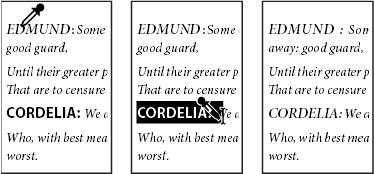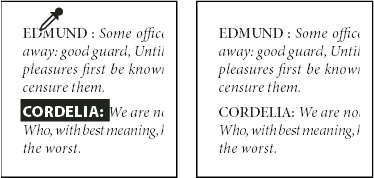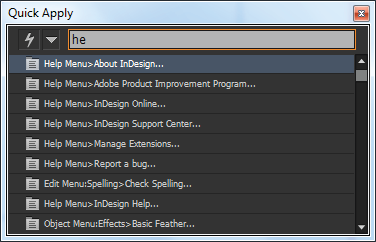Use the Control panel to change the appearance of text. When text is selected or when the insertion point is placed in text, the Control panel displays either the character formatting controls or the paragraph formatting controls, or a combination of both, depending on your monitor resolution. These same text formatting controls appear in the Character panel and Paragraph panel. You can also use the Character panel and Paragraphs panel to change the appearance of text.
For a video tutorial on formatting characters, see www.adobe.com/go/lrvid4275_id. For a video tutorial on formatting paragraphs, see www.adobe.com/go/lrvid4276_id.
Use the Character panel and Paragraphs panel to change the appearance of text. In InDesign, you can also use the Control panel to format text. The Control panel is not available in InCopy.
To format characters, you can use the Type tool
 to
select characters, or you can click to place the insertion point,
select a formatting option, and then begin typing.
to
select characters, or you can click to place the insertion point,
select a formatting option, and then begin typing.To format paragraphs, you don’t need to select an entire paragraph—selecting any word or character, or placing the insertion point in a paragraph will do. You can also select text in a range of paragraphs.
To set the formatting for all future text frames that you’ll create in the current document, make sure that the insertion point is not active and that nothing is selected, and then specify text formatting options. To set default text formatting for all new documents, close all documents, and then specify the text settings. See Set defaults.
Select a frame to apply formatting to all text inside it. The frame cannot be part of a thread.
Use paragraph styles and character styles to format text quickly and consistently.
For a video tutorial on working with text, see www.adobe.com/go/vid0075.
To format text with attributes such as font style and text direction, you can use several different methods. For example, you can use the Control panel, frame grid options, or named grids or text styles. If you use more than one method and attributes conflict with each other, InDesign must choose which attribute to use. The order of precedence is as follows:
For example, if you specify one font size in the Frame Grid Options dialog box and a different font size in a character style, the font size from character style is used. Similarly, if you include both a paragraph style and a named grid in an object style, the paragraph style takes precedence over the named grid.
-
 Control panel (when frame grid is selected)
Control panel (when frame grid is selected)
A. Reference point B. X Location C. Y Location D. Width E. Height F. Vertical scaling G. Horizontal scaling H. Character aki I. Line aki J. Grid format name K. Grid view L. Font size M. Frame grid characters per line N. Number of lines O. Number of columns P. Column gutter
You can use the Eyedropper tool to copy type attributes such as character, paragraph, fill, and stroke settings, and then apply those attributes to other type. By default, the Eyedropper tool copies all type attributes. To customize the attributes you want to copy with the Eyedropper tool, use the Eyedropper Options dialog box.
-
With the Eyedropper tool
 , click
the text that is formatted with the attributes you want to copy.
(The text can be in another open document.) The eyedropper pointer
reverses direction, and appears full
, click
the text that is formatted with the attributes you want to copy.
(The text can be in another open document.) The eyedropper pointer
reverses direction, and appears full  , to
indicate that it’s loaded with the attributes you copied. When you
position the eyedropper pointer over text, an I-beam appears next
to the loaded eyedropper
, to
indicate that it’s loaded with the attributes you copied. When you
position the eyedropper pointer over text, an I-beam appears next
to the loaded eyedropper  .
.
Note
To clear the formatting attributes currently
held by the eyedropper tool, press Alt (Windows) or Option (Mac OS)
while the Eyedropper tool is loaded. The Eyedropper tool reverses
direction and appears empty ![]() , to
indicate that it’s ready to pick up new attributes. Click an object
containing the attributes you want to copy, and then drop the new
attributes on another object.
, to
indicate that it’s ready to pick up new attributes. Click an object
containing the attributes you want to copy, and then drop the new
attributes on another object.

If you use the Eyedropper tool to copy a paragraph style from text in one document to text in another, and the paragraph style has the same name but different sets of attributes, any style differences will appear as local overrides to the destination style.
-
Using the Eyedropper tool
 , click
the text from which you want to copy attributes. (The text from
which you want to copy attributes must be in the same InDesign document
as the text you want to change.) The Eyedropper tool reverses direction
and appears full
, click
the text from which you want to copy attributes. (The text from
which you want to copy attributes must be in the same InDesign document
as the text you want to change.) The Eyedropper tool reverses direction
and appears full  , to
indicate that it’s loaded with the attributes you copied. The attributes
are applied to the text you selected in step 1.
, to
indicate that it’s loaded with the attributes you copied. The attributes
are applied to the text you selected in step 1.

Note
To copy or apply paragraph attributes only without having to change settings in the Eyedropper Options dialog box, hold down Shift as you click text with the Eyedropper tool.
Use Quick Apply to find and apply styles, menu commands, scripts, variables, and most other commands that can be found in the Keyboard Shortcuts dialog box.
-
The name you type doesn’t need to be an exact match. For example, typing he will locate styles such as Head 1, Head 2, and Subhead, as well as Help menu commands such as Help Menu > InDesign Help.
 Use Quick Apply to find styles, menu commands, scripts, and variables.
Use Quick Apply to find styles, menu commands, scripts, and variables.Note
You can narrow the search to only a single category by typing the appropriate prefix at the beginning of the search, such as m: for menu or p: for paragraph styles. To view a list of prefixes, click the down arrow to the left of the Quick Apply text box. You can deselect categories in this list that you don’t want to appear.
-
To apply a style, menu command, or variable, press Enter or Return.
To apply a paragraph style and remove overrides, press Alt+Enter (Windows) or Option+Return (Mac OS).
To apply a paragraph style and remove overrides and character styles, press Alt+Shift+Enter (Windows) or Option+Shift+Return (Mac OS).
To apply an item without closing the Quick Apply list, press Shift+Enter (Windows) or Shift+Return (Mac OS).
To close the Quick Apply list without applying an item, press Esc or click anywhere else in the document window.
To edit a style, press Ctrl+Enter (Windows) or Command+Return (Mac OS).
Note
When the Quick Apply list is displayed, press the left and right arrow keys to scroll through the edit field; press the up and down arrow keys to scroll through the list of items.


